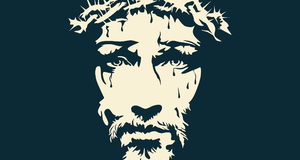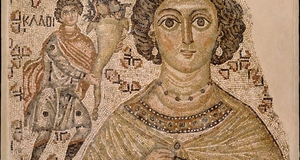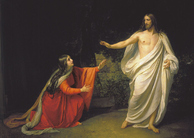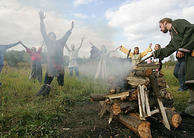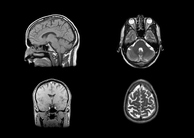Identifying a Developing Christian Culture in the Fourth Century
By
2017, Vol. 9 No. 02 | pg. 1/1 To briefly set the scene, the fourth century was a complex period for Christianity. It moved from being a persecuted sect to being supported by a new Christian Emperor, to vying with Constantine’s successors over unorthodox beliefs, to being persecuted by Julian the Apostate, and finally being declared the official state religion by Theodosius. So, with context in mind, this essay will attempt to identify if, by the end of the fourth century, a Christian culture had become distinctive, in and of itself, as well as more distinctive than the pagan Roman culture into which it originally emerged. To begin such an investigation, I offer the following definition of ‘culture’ for guidance: 
Thus, the primary interest is to examine some of the aspects of culture listed in part (a) within Christianity, and to analyse how distinctive they were in the fourth century. This essay concentrates on examining the following aspects of Christian culture: Christian literature, especially panegyric, and the development of ethics, as well as the development of ascetic and monastic movements. When examining these areas, this essay will try to remain as chronological as possible. This can help highlight where Christian culture gained momentum in the course of the fourth century, and acknowledge where contemporary circumstances might have affected it. More important, however, is to examine if these cultural aspects show evidence of influence from the surrounding Hellenic culture of the day. By doing so, this should allow for objective judgement about the distinctiveness of Christian culture as the fourth century came to a close. First then, let us look at the Christian literature of the fourth century period. During this period there are notable Christian figures at work such as Eusebius, Ambrose of Milan, Augustine of Hippo, John Chrysostom, Athanasius, Basil the Great, Gregory of Nazianzus and Gregory of Nyssa. These figures were preoccupied with different aspects of Christian life, such as ethical and moral living, and much of their literature reflected these concerns. The content of much of this literature advocated the Christian ascetic and monastic lifestyle that became increasingly popular in the fourth century. As such, I deal with fourth century Christian literature. First of all, I will examine panegyric, then scriptural interpretation, followed by ethical concerns, and finally moving onto specific references to ascetic living. Panegyric, what the “ancients would have called epideictic oratory”2, was by no means unique to Christianity. Indeed, Young describes Christian panegyric in the Post- Constantinian period as “the point of confluence between cultures.”3 As such, I feel beginning with an examination of Christian panegyric introduces us to how fourth century Christian writers were beginning to use Scripture to “replace the classics on which paideia was based”4. Yet, because of the confluence of cultures in this area of literature, it is also important to observe what Christianity adopted from Hellenic culture in the writing of their panegyric. Some of the well known examples of Christian panegyric in the fourth century came from John Chrysostom and the Cappadocian Fathers. However, offered for examination is Eusebius’ Oration on the Tricennalia of Constantine, composed in 336AD. This is a piece of panegyric that arguably reflects the status of Christianity under Constantine. To understand how culture is reflected by Eusebius, let us look to the text itself. Eusebius made immediate reference to a topic of much debate in the Church in the reign of Constantine - the nature of the Son of God:
Such a reference in an oration to the Christian Emperor is important, for Constantine was greatly involved in the Arian controversy, and presided over the Council of Nicaea in 325. The Emperor even provided the word “homoousios,” meaning ‘of the same substance’ to describe the nature of the Son to the Father.6 Therefore, when Eusebius vaguely referenced Scripture in his mention of a topical Christian debate, he also notably lacked use of the word ‘homoousios’, which suggests that Christian culture, despite liaising greatly with Imperial authority, did not feel dictated to by this authority. This possibly reflected the future of this debate, namely that wording for the nature of the Son would remain a problem for years to come. Eusebius then proceeded to flatter the attributes of the Emperor whilst still mindful of the Arian controversy. He thus hailed Constantine as “Preserver of the Universe” and as “the good shepherd [who] drives far away from his flock…apostate spirits…” Moreover, Eusebius defined the Emperor as “interpreter to the Word of God” who proclaimed to all on earth truth and godliness. Ultimately, Eusebius placed a great deal of responsibility on the shoulders of the Emperor, having stated his role was that of the pilot of a “mighty vessel,” to which he was appointed to save.7 What is remarkable about this panegyric is not only did Eusebius praise the Christian Emperor, but also subtly imposed on him a sense of duty to save the Empire. This was unique for Christian culture in this period, for it seems to have overturned the divisions in Hellenic society. This culture was not afraid to place responsibility on Imperial authority. Thus, the vague references to scripture in the Oration work to develop a sense of universal Christian kinship, even with the Emperor, who must care for his “crew” and his “flock.” However, I would also argue that Eusebius’ panegyric retains some of the conventions of Hellenic panegyric. For, according to Young, “praise involves the magnification of the subject” by features referred to as “auxēsis or amplificatio and synkrisis or comparatio” all of which Aristotle regarded as “characteristic of epideictic oratory.”8 Eusebius’ Oration includes some of these features. Eusebius indeed amplified the virtue of the Emperor by likening him to the image of the good shepherd and stating that he emulated the Divine example of the Saviour. Furthermore, he is described recurrently as the man bringing the entirety of the known world to God’s kingdom: the image Eusebius employed of the vessel which the Emperor pilots demonstrates this. Moreover, the strong contrast Eusebius drew in the action of Constantine against apostates and adversaries of the truth, acts as a powerful reminder of his efforts against Arius.9 As such, bearing these amplifications and comparisons in mind, let us examine what the theorist Menander Rhetor said about the various forms of epideictic speech, to see if such conventions apply to Eusebius’ Oration. For Menander, literature was the basis from which to draw examples for comparisons or synkriseis, as well to amplify the subject of the epideictic discourse.10 Therefore, rhetorical quotations could add weight to an argument. Thus, for Christian writers who found the inferiority of the Biblical style undeniable, they could instead adapt its superior content over the myths of pagan literature. As such, there developed a Christianised “intertextuality which functioned in similar ways to the literary tradition of their non- Christian peers.”11 The case of Eusebius’ Oration, where he adapted Scriptural images to amplify the Emperor’s deeds and virtues, follows Menander’s theories for the purpose of quoting other literature. Moreover, the importance of emulation or mimēsis cannot be ignored in the Oration, for “the transfer of biblical phraseology to describe current situations without regard to original context, even treating [Constantine] as the good shepherd, was an appropriate mimēsis.”12 Therefore, Christian panegyric could be viewed as having adapted conventions of pagan ‘epideictic oratory’, which predated it. Many of the Christian writers who formed the panegyric from this period were rhetorically schooled, and so could stylistically improve Biblical passages.13 By doing so, they could claim its authority over pagan myths, and even heresies, two areas Eusebius refuted in his Oration. Thus, Christian culture in the fourth century had effectively defined a distinctive form of panegyric by quoting authoritative truth from “barbarian”14 texts instead of the classics, and in doing so, challenged Hellenic societal divisions, all of which Eusebius’ Oration arguably exemplifies. Secondly, let us look in greater detail at the interpretation of Scripture. In this instance, specific works that interpret Scripture for ethical and moral purposes will be selected. Christian use of philosophy will also be highlighted in these interpretations. As the period under examination is the fourth century, it might be reasonable to assert that Christian writers no longer needed to produce apologetic writings to defend their faith. It might be fair to state that their primary concern became evangelising, exhortation and edification for the Christian community. Thus, the development of ethical writing appeared, and encouraged the ascetic and monastic movements of this period. Athanasius’ writing on the Fall is a good starting point. According to Kelly, this account “is a blend of Platonizing metaphysics and the Genesis story,” for Athanasius claimed that Adam and Eve were distracted by the physical world, particularly by their bodies, and lapsed into sin.15 Thus, when Athanasius wrote about human nature and the incarnation, he understood it in the manner of Platonic realism. For him, the incarnation meant the Word became flesh, suffused the flesh with Divinity, and this divinising force was communicated to all mankind, so the “incarnation would in effect be the redemption.”16 As a result of such philosophical interpretations of the Biblical creation narrative, various writers began to emerge with distinctive ideas about free will. John Chrysostom wrote numerous homilies about human free will which stated that “All evil is the product of man’s free will and choice” for “the ruler of the universe made our nature free.”17 Resultantly, much of Scripture was interpreted to encourage the attainment of righteousness and so the ascetic movement was born. Thus asceticism could be viewed as a “step-by-step return of the world potencies into God, unambiguously away from the material to the spiritual.”18 Such philosophical interpretations by educated Christian elite highlighted the competition Christianity faced from the Greek philosophical schools. By expounding meaning using philosophical means Christianity was entering “new circles of the dominant culture around it.”19 Therefore, Christian culture appeared distinctive amidst Hellenic culture, for its beliefs were explained in the same language of secular culture in order to show its superiority. Christian culture adopted and then adapted the means of communication and its disposal to better educate believers and non- believers of the message and how it should impact upon their lives. Arguably, the resultant Christian ascetic movement is the most distinctive aspect of Christian culture in the fourth century. Despite existence of accounts like the fictional biography of Appollonius of Tyana, there is nothing on quite the same scale in Hellenic tradition.20; the other philosophical ascetics did not possess the complete truth as Christianity proclaimed it, and so their ascetic lifestyles were not on the same scale. Horton points out that “through practical philosophy or the active life of the Christian…some believers…through mystical union…were able to move further still, from the mind of Christ to his very Godhead.”21 For Christians such a union with Christ was desired, for in Greco- Roman society, Christians applied the terms paroikoi and xenoi when classing themselves as resident aliens.22 It was only in the reign of Constantine that Christians began to feel “more at home in the world, so the call of the desert became audible, at first for a few, later on for many.”23 This might seem odd that Christians should want to retire from society, given that they enjoyed protection and favour for most of the fourth century. However, through the exercise of philosophical interpretation of Scripture, especially that by Athanasius and Gregory about the temptation in the Garden of Eden24, the desert seemed the ideal place to remove oneself from such temptation under the bountiful Constantine. Now, to examine how distinctive this aspect of Christian culture was by the end of the fourth century, it is important to look at writings advocating this lifestyle. Athanasius’ account of the life of Antony is probably one of the best known records of Christian ascetic life. What is immediately intriguing about the figure of Antony is that he retired to a life of asceticism before the time of the Great Persecution, and as a result of Christian scripture read at a Church service.25 Perhaps then, this practice in Christian culture has less to do with philosophical reasoning and more to do with widespread popularity of this impressive man? Should this be the case, asceticism would be all the more distinctive in Christian culture in the fourth century, as this man was swayed simply by scripture and not by philosophical interpretation. At the age of fifty five, Antony’s “body had kept its former appearance, that it was neither obese from want of exercise, not emaciated from fastings…his soul was pure…”26 This balance Antony’s body attained in the wilderness seems suggestive of the perfection that was lost in the Garden of Eden.27 Perhaps then the philosophising of Athanasius and Gregory was not off the mark, and asceticism was a means to attain paradise? Moreover, an ascetic lifestyle might be the next best thing to martyrdom for those Christians living in the period after the Great Persecution? After all, it was unique to Christian culture for yearning and acceptance of death: martyrdom was a way to immediately return to the paradise lost. Asceticism was the next best thing, as there would be physical removal from the temptation of daily life, but there would remain the challenge of spiritual struggle in the wilderness. The example of Antony can work on another level, however. Philosophical interpretation of scripture might convert the learned Greek, however, Antony wanted people to abandon logical reasoning. For him, “people first trust what they can actually see, and then in reasoned argument.”28 This statement could accurately work for simple folk, who did not have the learning of well known Christian writers, and so the example Antony set acted as a calling to the ascetic life. Gregory of Nyssa’s work “On Virginity” and the collected letters of Saint Basil, argue that it was daily temptation in the world that should encourage Christians of the fourth century to seek solitude in the desert. They both believed the “bonds of matrimony is greatly disturbed by violent desires” and so Christians should remove themselves from “sympathy with the body.”29 Gregory cares greatly for the idealistic state of virginity and goes to great lengths to put marriage to disrepute. Marriage is deemed “compensation” for the death humanity endures as a result of the Fall, that marriage is an “executioner” for children, but by remaining virginal Christians are prepared for a spiritual marriage with Christ.30 These ideals are demonstrated in Ambrose’s correspondence with female virgins of the ascetic movement. This correspondence highlighted development of societal defiance by Christian women in the fourth century. For he insisted that offering a daughter to the Church was a family investment, as they would be redeemed by the daughter’s merits while she continued to live at home, saving pain of loss and an expensive dowry.31 Thus, by all means, Ambrose encouraged the girls to imitate their aristocratic counterparts in Rome when refusing to be used as matrimonial pawns.32 As a result, we have the example of a young girl who took refuge at the altar, hurling defiance at her family by declaring they could find no bridegroom better than the one she had found already in Christ.33 As such, a monastic lifestyle was being nurtured by these writings. Basil outlines in intimate detail how day to day life is to be carried out in the desert, from the nature of conversation, to learning, to how one’s voice should sound, to agreeableness of one’s personality etc.34 In The Life of Saint Antony, many visited Antony for advice and wisdom, and so the ascetic and monastic movement was built on Father visiting Father.35 The Desert Fathers are an example of a developed monastic community. Therefore, cities grew in the desert, and so it seems that the Christian ascetic movement, which evolved from separating from pagan society, created a new Christian community in the wilderness “separated from all and united with all.”36 Contemporary Hellenic culture possessed no such separated community, which thus highlights the distinctiveness of such a movement in Christian culture in the fourth century. Therefore, in conclusion, one can definitely speak of a distinctive Christian culture in the fourth century. Yes, it had adopted some classical and philosophical conventions from Hellenic culture: the Christian panegyrist Eusebius and philosophical Christian writers Athanasius and Gregory exemplify this. Indeed, the very fact Constantine himself, as Pontifex Maximus of a largely pagan Empire, composed Christian panegyric37 strongly suggests that Hellenic conventions would be maintained. Perhaps, however, this adoption of Hellenic convention is what makes Christian culture in this period all the more distinctive? By competing with paganism in its own language, in its own style, and via its own methods, Christian exposition of Scripture outshone that of contemporary Greek philosophical schools. Moreover, a call to abandon such reasoned argument by rigorous ascetics such as Antony highlights the extremes of Christian ascetic lifestyle in this period. It was unparalleled by even the ascetical ‘philosophical life’, for Dodds believes fourth century Christian asceticism was far removed from the old Greek meaning for this lifestyle, which Plato and Aristotle understood simply as ‘training’.38 The Desert Fathers draped themselves in chains and killed their body for it killed their soul,39 an exemplary distinction of Christian culture in a pagan world. ReferencesAthanasius, The Life of Saint Antony, tr. R.T. Meyer (Ancient Christian Writers, 10; 1950). Basil, Letter Two (Loeb Classical Library ed. of Basil’s letters) (Seminar Text). Chadwick, H., The Early Church (London, Penguin Books Ltd., rev. ed, 1993). Chrysostom, J., ‘Homily on Romans, 19:6; Homily on Acts 23:3; Homily on Genesis 19:1’ in E. Osborn, Ethical Patterns in Early Christian Thought (Cambridge: Cambridge University Press, 1976). Dodds, E.R., Pagan and Christian in an Age of Anxiety (Cambridge: Cambridge University Press, 1965). Eusebius, ‘Oration on the Tricennalia of Constantine, AD 336, 2.1-5’, in J. Stevenson and W.H.C. Frend ‘eds’., A New Eusebius (Cambridge, SPCK, 2nd rev, ed., 1987). Fox, R.L., Pagans and Christians (London: Viking, 1986). Gregory of Nyssa, On Virginity (Nicene and Post Nicene Fathers) (Seminar Text). Horton, M. S., Covenant and Salvation: Union with Christ (Louisville: John Knox Press, 2007). Kelly, J.N.D., Early Christian Doctrines, (Peabody: Prince Press, rev. ed., 2003). Louth, A., The Wilderness of God (London: Darton, Longman and Todd Ltd., 2003). MacMullen, R., Christianising the Roman Empire(Massachusetts: Yale University Press, 1984). McLynn, N.B., Ambrose of Milan (California: University of California Press, 1994). Young, F., Biblical Exegesis and the formation of Christian Culture (Cambridge: Cambridge University Press, 1997). Endnotes1.) “culture,” American Heritage Dictionary. http://resources.blackboard.com/dictionary/index.jsp?word=culture&dict=AHD. Accessed 03.02.2009 2.) F. Young, Biblical Exegesis and the formation of Christian Culture (Cambridge: Cambridge University Press, 1997) p.97 3.) Ibid. pp. 96-7 4.) Ibid. p.95 5.) Eusebius, ‘Oration on the Tricennalia of Constantine, AD 336, 2.1-5’, in J. Stevenson and W.H.C. Frend ‘eds’., A New Eusebius (Cambridge, SPCK, 2nd rev, ed., 1987) p. 367 6.) H. Chadwick, The Early Church (London, Penguin Books Ltd., rev. ed, 1993) p.130 7.) Eusebius, ‘Oration on the Tricennalia of Constantine, AD 336, 2.1-5’ p. 367 8.) F. Young, Biblical Exegesis and the formation of Christian Culture p. 102 9.) Eusebius, ‘Oration on the Tricennalia of Constantine, AD 336, 2.1-5’ p. 367 10.) F. Young, Biblical Exegesis and the formation of Christian Culture p. 103 11.) Ibid. p.103 12.) F. Young, Biblical Exegesis and the formation of Christian Culture p. 103 13.) Ibid. p.103 14.) Ibid. p.49 15.) J.N.D, Kelly, Early Christian Doctrines, (Peabody: Prince Press, rev. ed., 2003) p.287 16.) Ibid. pp.378-379 17.) J. Chrysostom, ‘Homily on Romans, 19:6; Homily on Acts 23:3; Homily on Genesis 19:1’ in E. Osborn, Ethical Patterns in Early Christian Thought (Cambridge: Cambridge University Press, 1976) pp. 134-135 18.) M. S. Horton, Covenant and Salvation: Union with Christ (Louisville: John Knox Press, 2007) p.207 19.) R. MacMullen, Christianising the Roman Empire (Massachusetts: Yale University Press, 1984) p.106 20.) E.R. Dodds, Pagan and Christian in an Age of Anxiety (Cambridge: Cambridge University Press, 1965) p.34 21.) M. S. Horton, Covenant and Salvation: Union with Christ p.305 22.) A. Louth, The Wilderness of God (London: Darton, Longman and Todd Ltd., 2003) p.43 23.) Ibid. p.45 24.) J.N.D, Kelly, Early Christian Doctrines p.348 25.) A. Louth, The Wilderness of God p.46 26.) Athanasius, The Life of Saint Antony, tr. R.T. Meyer (Ancient Christian Writers, 10; 1950) 27.) A. Louth, The Wilderness of God p.47 28.) R. MacMullen, Christianising the Roman Empire p.112 29.) Basil, Letter Two (Loeb Classical Library ed. of Basil’s letters) (Seminar Text) 30.) Gregory of Nyssa, On Virginity (Nicene and Post Nicene Fathers) (Seminar Text) 31.) N.B. McLynn, Ambrose of Milan (California: University of California Press, 1994) p. 62 32.) Ibid. p.62 33.) Ibid. p.62 34.) Basil, Letter Two 35.) A. Louth, The Wilderness of God p.58 36.) Ibid. p.59 37.) R.L. Fox, Pagans and Christians (London: Viking, 1986) p.626 38.) E.R. Dodds, Pagan and Christian in an Age of Anxiety p.30 39.) Ibid. p.30 Suggested Reading from Inquiries Journal
Inquiries Journal provides undergraduate and graduate students around the world a platform for the wide dissemination of academic work over a range of core disciplines. Representing the work of students from hundreds of institutions around the globe, Inquiries Journal's large database of academic articles is completely free. Learn more | Blog | Submit Latest in Theology |









